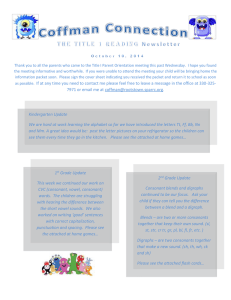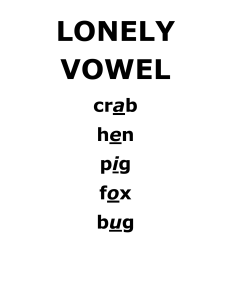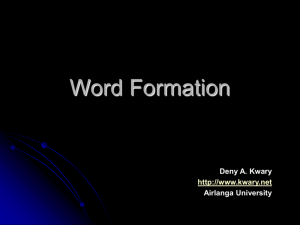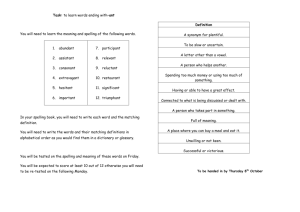Kindergarten Children’s Segmentation and Representation of Consonant Blends: Educational Implications ♦
advertisement
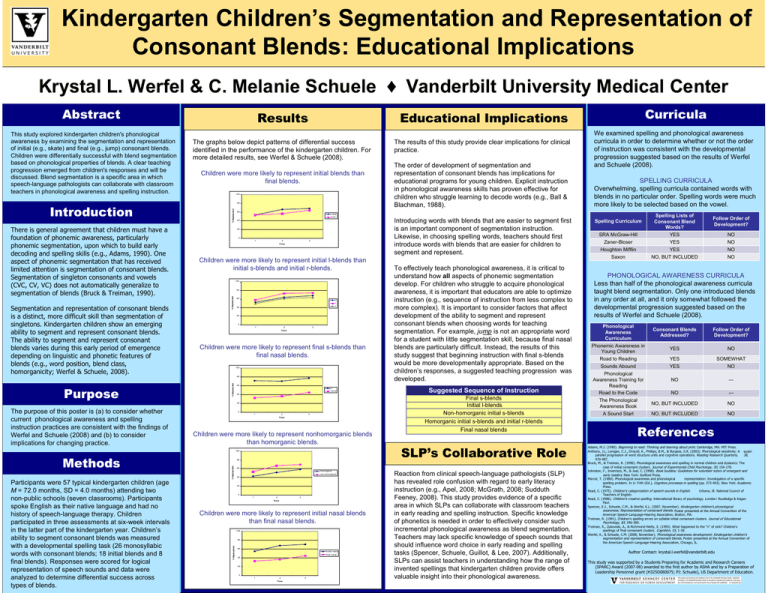
Kindergarten Children’s Segmentation and Representation of Consonant Blends: Educational Implications Krystal L. Werfel & C. Melanie Schuele ♦ Vanderbilt University Medical Center Abstract There is general agreement that children must have a foundation of phonemic awareness, particularly phonemic segmentation, upon which to build early decoding and spelling skills (e.g., Adams, 1990). One aspect of phonemic segmentation that has received limited attention is segmentation of consonant blends. Segmentation of singleton consonants and vowels (CVC, CV, VC) does not automatically generalize to segmentation of blends (Bruck & Treiman, 1990). Segmentation and representation of consonant blends is a distinct, more difficult skill than segmentation of singletons. Kindergarten children show an emerging ability to segment and represent consonant blends. The ability to segment and represent consonant blends varies during this early period of emergence depending on linguistic and phonetic features of blends (e.g., word position, blend class, homorganicity; Werfel & Schuele, 2008). The graphs below depict patterns of differential success identified in the performance of the kindergarten children. For more detailed results, see Werfel & Schuele (2008). The results of this study provide clear implications for clinical practice. Children were more likely to represent initial blends than final blends. 100 80 % Represented Introduction Educational Implications Introducing words with blends that are easier to segment first is an important component of segmentation instruction. Likewise, in choosing spelling words, teachers should first introduce words with blends that are easier for children to segment and represent. 0 1 2 3 Time Children were more likely to represent initial l-blends than initial s-blends and initial r-blends. 100 80 60 s l r 40 20 0 1 2 3 Time Children were more likely to represent final s-blends than final nasal blends. 100 % Represented s nasal 40 0 1 2 3 Time Children were more likely to represent nonhomorganic blends than homorganic blends. % Represented 80 Suggested Sequence of Instruction Final s-blends Initial l-blends Non-homorganic initial s-blends Homorganic initial s-blends and initial r-blends Final nasal blends SLP’s Collaborative Role 60 homorganic non-homorganic 40 20 0 1 2 3 Time Children were more likely to represent initial nasal blends than final nasal blends. 100 80 % Represented Participants were 57 typical kindergarten children (age M = 72.0 months, SD = 4.0 months) attending two non-public schools (seven classrooms). Participants spoke English as their native language and had no history of speech-language therapy. Children participated in three assessments at six-week intervals in the latter part of the kindergarten year. Children’s ability to segment consonant blends was measured with a developmental spelling task (26 monosyllabic words with consonant blends; 18 initial blends and 8 final blends). Responses were scored for logical representation of speech sounds and data were analyzed to determine differential success across types of blends. To effectively teach phonological awareness, it is critical to understand how all aspects of phonemic segmentation develop. For children who struggle to acquire phonological awareness, it is important that educators are able to optimize instruction (e.g., sequence of instruction from less complex to more complex). It is important to consider factors that affect development of the ability to segment and represent consonant blends when choosing words for teaching segmentation. For example, jump is not an appropriate word for a student with little segmentation skill, because final nasal blends are particularly difficult. Instead, the results of this study suggest that beginning instruction with final s-blends would be more developmentally appropriate. Based on the children’s responses, a suggested teaching progression was developed. 60 100 Methods SPELLING CURRICULA Overwhelming, spelling curricula contained words with blends in no particular order. Spelling words were much more likely to be selected based on the vowel. Spelling Curriculum Spelling Lists of Consonant Blend Words? Follow Order of Development? SRA McGraw-Hill Zaner-Bloser Houghton Mifflin Saxon YES YES YES NO, BUT INCLUDED NO NO NO NO final 20 The purpose of this poster is (a) to consider whether current phonological awareness and spelling instruction practices are consistent with the findings of Werfel and Schuele (2008) and (b) to consider implications for changing practice. We examined spelling and phonological awareness curricula in order to determine whether or not the order of instruction was consistent with the developmental progression suggested based on the results of Werfel and Schuele (2008). initial 40 80 Purpose The order of development of segmentation and representation of consonant blends has implications for educational programs for young children. Explicit instruction in phonological awareness skills has proven effective for children who struggle learning to decode words (e.g., Ball & Blachman, 1988). Curricula 60 20 % Represented This study explored kindergarten children's phonological awareness by examining the segmentation and representation of initial (e.g., skate) and final (e.g., jump) consonant blends. Children were differentially successful with blend segmentation based on phonological properties of blends. A clear teaching progression emerged from children's responses and will be discussed. Blend segmentation is a specific area in which speech-language pathologists can collaborate with classroom teachers in phonological awareness and spelling instruction. Results 60 initial nasal final nasal 40 20 0 1 2 Time 3 Reaction from clinical speech-language pathologists (SLP) has revealed role confusion with regard to early literacy instruction (e.g., Apel, 2008; McGrath, 2008; Sudduth Feeney, 2008). This study provides evidence of a specific area in which SLPs can collaborate with classroom teachers in early reading and spelling instruction. Specific knowledge of phonetics is needed in order to effectively consider such incremental phonological awareness as blend segmentation. Teachers may lack specific knowledge of speech sounds that should influence word choice in early reading and spelling tasks (Spencer, Schuele, Guillot, & Lee, 2007). Additionally, SLPs can assist teachers in understanding how the range of invented spellings that kindergarten children provide offers valuable insight into their phonological awareness. PHONOLOGICAL AWARENESS CURRICULA Less than half of the phonological awareness curricula taught blend segmentation. Only one introduced blends in any order at all, and it only somewhat followed the developmental progression suggested based on the results of Werfel and Schuele (2008). Phonological Awareness Curriculum Phonemic Awareness in Young Children Road to Reading Sounds Abound Phonological Awareness Training for Reading Road to the Code The Phonological Awareness Book A Sound Start Consonant Blends Addressed? Follow Order of Development? YES NO YES YES SOMEWHAT NO NO --- NO --- NO, BUT INCLUDED NO NO, BUT INCLUDED NO References Adams, M.J. (1990). Beginning to read: Thinking and learning about print. Cambridge, MA: MIT Press. Anthony, J.L, Lonigan, C.J., Driscoll, K., Phillips, B.M., & Burgess, S.R. (2003). Phonological sensitivity: A quasi38, parallel progression of word structure units and cognitive operations. Reading Research Quarterly, 470-487. Bruck, M., & Treiman, R. (1990). Phonological awareness and spelling in normal children and dyslexics: The case of initial consonant clusters. Journal of Experimental Child Psychology, 50, 156-178. Johnston, F., Invernizzi, M., & Juel, C. (1998). Book buddies: Guidelines for volunteer tutors of emergent and early readers. New York: Guilford Press. Marcel, T. (1980). Phonological awareness and phonological representation: Investigation of a specific spelling problem. In U. Frith (Ed.), Cognitive processes in spelling (pp. 373-403). New York: Academic Press. Read, C. (1975). Children's categorization of speech sounds in English. Urbana, Ill: National Council of Teachers of English. Read, C. (1986). Children's creative spelling. International library of psychology. London: Routledge & Kegan Paul. Spencer, E.J., Schuele, C.M., & Werfel, K.L. (2007, November). Kindergarten children’s phonological awareness: Representation of consonant blends. Poster presented at the Annual Convention of the American Speech-Language-Hearing Association, Boston, MA. Treiman, R. (1991). Children’s spelling errors on syllable-initial consonant clusters. Journal of Educational Psychology, 83, 346-360. Treiman, R., Zukowski, A., & Richmond-Welty, E. (1995). What happened to the "n" of sink? Children's spellings of final consonant clusters. Cognition, 55, 1-38. Werfel, K., & Schuele, C.M. (2008, November). Phonological awareness development: Kindergarten children’s segmentation and representation of consonant blends. Poster presented at the Annual Convention of the American Speech-Language-Hearing Association, Chicago, IL. Author Contact: krystal.l.werfel@vanderbilt.edu This study was supported by a Students Preparing for Academic and Research Careers (SPARC) Award (2007-08) awarded to the first author by ASHA and by a Preparation of Leadership Personnel grant (H325D080075; PI: Schuele), US Department of Education.
